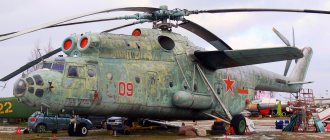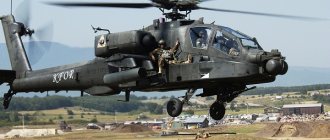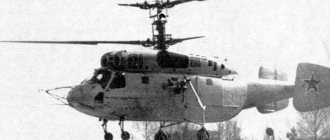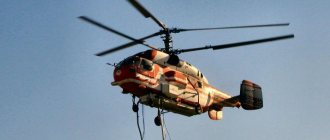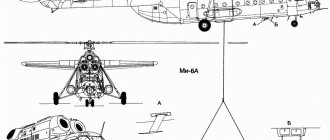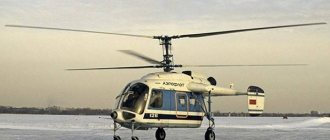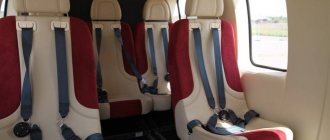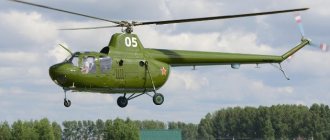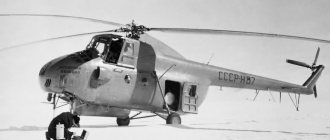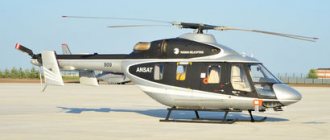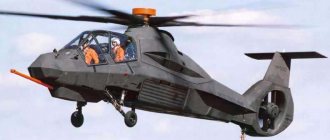Weapons and Armament > Helicopters > Multi-purpose > Ka-26 multi-purpose helicopter
The Kamov Ka-26 general purpose helicopter, called Hoodlum in NATO reports, appeared in early 1964. It had a traditional tail with two fins and a stabilizer connecting them, attached to a double-beam fuselage. The device stood on a four-wheeled chassis and was equipped with two Vedeneev M-14V-26 star-shaped piston engines with a power of 242 kW. The engines were placed in engine nacelles on short horizontal pylons in the upper part of the fuselage. The cockpit was closed and equipped for the operation of one pilot. The rest could be used for various purposes: pollination and spraying in agriculture, air ambulance, cargo and passenger transport.
More than 850 Ka-26A variants have been built and are in civilian service in approximately 15 countries, as well as in the air forces of Hungary, Bulgaria and Sri Lanka. A modified Ka-26 with a jet control system designed for the planned Ka-118 helicopter (similar to the McDonnell-Douglas Corporation NOTAR system) is currently being tested.
CHARACTERISTIC
Modifications
During its operation, the Mi-1 was repeatedly modernized, and numerous modifications were created. Here are the main ones:
- Mi-1. Basic modification of the machine that was put into operation. Could carry two passengers.
- Mi-1NX. A modification that was most actively used for civilian needs: transporting mail and passengers, transporting the sick and wounded, cultivating agricultural land. To perform each of the above tasks, a separate version of this helicopter was produced. The passenger version had additional space for one more passenger, the sanitary version had side removable gondolas, and the agricultural version had equipment for spraying fields.
- Mi-1U. A modification for pilot training, it was equipped with dual controls and a seat for an instructor, and was widely used in flight schools and in DOSAAF.
- Mi-1P. Modification equipped with floats for landing on water. Widely used by Soviet whalers.
- Mi-3. This machine is a deep modernization of the base model. It was made by order of the military and was used as an ambulance helicopter. The Mi-3 had a new four-blade main rotor, a more comfortable cabin, and gondolas for transporting the wounded.
- SM-1. This is a modification of the Mi-1, created in Poland by specialists from PZL Swidnik. The helicopters were manufactured entirely from Polish components; only the engine was Soviet.
- SM-2. Improved version of SM-1.
Initially, helicopters were used in the armed forces to provide communications, reconnaissance and surveillance, and evacuate the wounded from the battlefield. However, already in the 50s, the first attack helicopters appeared in the West. They tried to do something similar with the Mi-1. In 1958, a modification of the helicopter appeared, armed with two containers with TRS-132 unguided rockets. Later they tried to install machine guns, guided anti-tank missiles, and aircraft machine guns in hanging containers on the Mi-1.
Around the same time, they planned to make an anti-submarine helicopter from the Mi-1, but the power of its power plant was not enough to transport search equipment and weapons.
Ka-26 in films
The widespread use of the Ka-26 helicopter in agriculture and the traffic police of the USSR predetermined its demand on the Soviet movie screen. He can be seen in many detective and comedy films from 1970 to 1990.
- In the parody comedy “Old Robbers,” the hero of Yuri Nikulin flies over the city in his dreams, hanging on a ladder attached to a helicopter.
- In the comedy film “A Dog Walked Along the Piano,” the agricultural Ka-26, like its young pilot, is practically one of the heroes of the film.
- In the film "Everything will be fine!" A traffic police helicopter escorts the convoy.
- In the children's film "Three Fun Shifts" in the second film, Pavel, Mikoshi's friend, works on the Ka-26.
- In the detective film "Detective" there is a traffic police helicopter.
- In the 1980 Hungarian comedy-detective film “The Pagan Madonna,” detective-superman Droplet pursues international criminals in a Ka-26 in the colors of the local traffic police.
Description
The Mi-1 helicopter is designed according to the classical design with one main rotor and a tail rotor on the end boom. The fuselage of the vehicle is a semi-monocoque type, with an end beam deflected upward and controlled by a stabilizer. The fuselage skin is made of aluminum alloy. The helicopter landing gear is non-retractable, tricycle.
In front of the fuselage there was a glass cockpit for the pilot and passengers. Seats for two passengers were located immediately behind the pilot's seat. At the rear of the fuselage there was an engine compartment with a motor, main gearbox, main rotor brake and axial fan.
The Mi-1 main rotor is three-bladed, the blades are hinged, and the propeller is equipped with friction dampers. The blades are trapezoidal in shape; they have a mixed design - steel spars and wooden ribs, covered with plywood and canvas on top. The latest modifications of the Mi-1 had all-metal blades. The tail rotor also has three trapezoidal blades; they were made of wood.
The main landing gear of the helicopter has a truss structure, and the front wheel is self-orienting. There is a tail foot on the end boom to prevent the tail rotor from touching the ground. The Mi-1 helicopter was equipped with a parking brake.
The Mi-1 power plant consisted of a star-shaped AI-26V piston engine, which was installed horizontally and rotated the main rotor through a gearbox, and the tail rotor through a system of shafts and gearboxes. The engine was started using compressed air, the supply of which was relatively small. To be able to take off in remote areas (taiga, mountains), pilots often carried an additional cylinder with them.
The helicopter had a fuel tank with a capacity of 240 liters. On the Mi-1 it was possible to install an additional tank for 160 liters of fuel.
Manual control system
The manual control system is a digital remote control system (RCS) without mechanical backup. The SDU, together with the aircraft on-board equipment (OBE), is designed to control the elevators, ailerons, spoilers (in lateral control and air brake modes) from passive side handles and the rudder from the pedals, as well as the stabilizer and brake flaps.
The computing part of the SDS is made according to the “2 sides” scheme, i.e. is divided into two subsystems, and has digital inter-machine exchange lines for transmitting information to computers on the other side in order to control the data and ensure their identity in different channels.
The computing part includes upper-level CDS computers (PFCU) and lower-level computers (ACE) - drive control modules. ACE modules provide analog control signals for electrohydraulic drives. The system of connections between CDS elements and interacting systems is based on the use of digital communication lines via ARINC-429 and analog lines.
The SDS provides the specified characteristics of stability and controllability and meets the requirements of the certification basis in full. The SDS is easily adaptable to any aircraft variant while maintaining a high level of reliability.
Passive side handles and mechanically interconnected pedals of the crew commander and co-pilot are used as controls for pitch, roll and yaw.
The SDU provides: − automatic limitation of the maximum angle of attack α and normal overload ny; − automatic balancing in the longitudinal channel; − stabilization of the angular position of the aircraft in roll and pitch when the pilots do not intervene in the controls (after the end of the pilots’ intervention in the controls); − increasing speed stability at V>VMO and M>MMO; − increasing the spiral stability of the aircraft at |γ|≥|γ|max; − automatic parrying of the disturbing yaw moment in case of engine failure during takeoff, landing and go-around, as well as generating a signal to the engine control system to allow the high-thrust mode (APR) with the engine running during take-off and go-around modes; − automatic parrying of disturbances caused by changes in aircraft configuration; − automatic braking of the aircraft during the run using spoilers and brake flaps; − automatic limitation of rudder deflection depending on Vap.; − processing of signals from the automatic flight control system (ACS)
The SDS has three operating modes, determined by the state (serviceability) of its own elements of the SDS and the state (serviceability) of interacting systems: − “Main” mode, implemented when the SDS elements and interacting systems are fully serviceable; − “Simplified” mode, implemented in case of failure of interacting systems. In this mode, only some of the functions are implemented. The transition from the “basic” mode to the “simplified” mode occurs automatically without shock in the event of failures in the interacting systems. − “Minimum” mode, implemented in the event of failure of CDS elements or interacting systems. In the “minimum” mode, direct control of the control surfaces is provided using the simplest algorithm, allowing you to safely complete the flight. The transition to the “minimum” mode also occurs automatically without shock.
History of creation
Development of the Ka-32, as well as its military version Ka-27PS, began in 1969. The leadership of Soviet civil aviation wanted to get a helicopter made in a coaxial design that could take off from a ship's deck. Initially, it was planned to be used as a means of reconnaissance of ice conditions in the Arctic.
However, later the range of tasks for the new machine was expanded. It was planned to be used as a search and rescue vehicle, for transporting goods and passengers, for installation work, patrol service and for solving other problems.
The first flight of the pre-production Ka-32 took place at the end of 1973, the production vehicle took off in 1980. In 1978, the helicopter took part in escorting a convoy of ships led by the icebreaker Sibir along the Northern Sea Route. The helicopter coped with its tasks, operating in very difficult conditions of the polar night.
In 1981, the Ka-32 was demonstrated to foreign experts, and in 1985 the helicopter was shown at the Le Bourget air show.
The machine has excellent characteristics in terms of load capacity, power supply, consumes relatively little fuel, and is easy to control. The latest modifications of the helicopter are certified in accordance with international requirements (FAR-29, AP-29, EASA).
History of creation
By the end of the 50s, it became clear that the first production domestic helicopter, the Mi-1, did not meet the requirements of the time. They tried to modernize it several times; there were projects to install a gas turbine engine (GTE) on it, but they remained on paper. What was needed was a new machine with more advanced flight characteristics.
Mil proposed creating a helicopter with two gas turbine engines at once. This design of the power plant significantly increased the reliability of the machine and flight safety, because if one of the engines failed, the helicopter could fly using the second
Civil aviation management showed great interest in the development of the new machine, and later the military also paid attention to the helicopter.
The Mil OKB began designing a new car at the beginning of 1960. The designers were given the task of developing a helicopter that could be used to transport cargo and passengers, for military purposes, as well as for the needs of air ambulances and the cultivation of agricultural land.
While working on the Mi-2, the designers tried to make maximum use of the units and components of the Mi-1 helicopter in order to reduce the cost of the new machine.
The power plant for the Mi-2 was developed at the Leningrad OKB-117, the result of which was the GTD-350 engine (400 hp). Its characteristics made it possible to create a new helicopter in the shortest possible time, which in its dimensions was almost equal to the Mi-1, but at the same time had a greater payload and passenger capacity, and also significantly exceeded it in basic flight performance parameters.
At the beginning of 1961, the prototype of the future helicopter was approved, and in the fall of the same year, the first prototype took off. Already at the stage of state testing, the Mi-2 set a speed record for helicopters of this class. In the fall of 1962, the Mi-2 helicopter was presented to the Soviet government and the leadership of the Polish People's Republic.
Tests have shown that the helicopter engine needs improvement. The design of the power plant as a whole was also changed, which increased the ease of its maintenance. This changed the shape of the cabin. The designers had to completely redesign the main rotor and create a new tail rotor with more thrust.
The Soviet Union, for its part, guaranteed the regular purchase of a large number of helicopters, as well as spare parts for them.
On August 26, 1965, the first Mi-2 helicopter, made by the Poles from Soviet components, took off in Poland. In November of the same year, the Mi-2, entirely manufactured in Poland, made its first flight.
Mass production of the car began in 1966; production cars were somewhat different from the prototypes made in the USSR. They did not have a keel surface under the tail boom, the shape of the upper part of the fuselage was slightly different, and the location of the antennas and flashing lights was changed.
The Mi-2 helicopter was shown to the general public during an exhibition in Le Bourget in 1967. In the West, this vehicle was designated Hoplite. For their assistance in establishing mass production, many employees of the Mil Design Bureau were awarded Polish government awards. Among them was the General Designer Mil, he received the Commander's Cross of the Order of the Renaissance of Poland.
Wing lift control system
The wing mechanization control system includes control systems for flaps and slats and operates in a tracking (manual) mode according to signals from the mechanization control knob. There are restrictions for the release of mechanization in a configuration in which VFE is automatically released upon a signal from the control system, and when the speed is restored, it is correspondingly removed.
The flaps are controlled by a two-channel fly-by-wire system. The system is driven by an electromechanism with two valve-type non-contact electric motors with electromagnetic braking clutches. The rotation of the drive is transmitted through a system of gearboxes and transmission shafts to the actuating ball screw mechanisms, the nuts of which move along the rails of the flap carriage. The flap extension trajectory is determined by the deflection mechanisms on the rails along which the flap sections extend.
If one control channel fails, the flaps move over the full range of angles with a speed reduced by half.
The slats are controlled by a two-channel fly-by-wire system. The system is driven by an electromechanism with two valve-type non-contact electric motors with electromagnetic braking clutches. The rotation of the drive is transmitted through a system of gearboxes and transmission shafts to executive planetary gearboxes, the gears of which move toothed arc-shaped racks with rails and sections of slats attached to them.
If one channel of the fly-by-wire system fails, the slats are deflected in the full range of angles with a speed reduced by half.
Structural elements
The Ka-27 combat helicopter is equipped with three-blade counter-rotating propellers that fold when stationary on the ship. The blades of these propellers are made of fiberglass, and their bushings are made of titanium.
The fuselage of the vehicle is made of solid aluminum alloy. To ensure stable provision of both longitudinal and directional stability of the helicopter, a tail unit with two fins is used. The washer of each fin has an uncontrolled slat and is turned with its toe towards the axis of the fuselage itself.
The landing gear has four non-retractable legs and is equipped with a hydraulic system for slightly lifting the helicopter in order to provide convenient access to the cargo compartment. A characteristic feature of the front wheels is self-orientation. It is also possible to install skis.
Characteristics
Below are the characteristics of the Mi-2:
- rotor diameter - 4.5 m;
- tail rotor diameter - 2.7 m;
- fuselage length - 11.4 m;
- fuselage width - 3.25 m;
- normal take-off weight – 3500 kg;
- Max. take-off weight – 3550 kg;
- engine - 2 × GTD-350;
- power - 2 × 400 l. With.;
- crew – 1 person;
- number of passengers – 10 people;
- Max. speed – 210 km/h;
- range – 580 km;
- ceiling – 4000 m.
Author of the article:
Egorov Dmitry
I am interested in military history, military equipment, weapons and other issues related to the army. I love the written word in all its forms.
History of the Ka-226
According to research by marketers within the country in the market for air transportation of cargo and passengers by helicopter, 80% of the total number is carried out on light-class helicopters. Due to the fact that the Ka-26 and Mi-2 were no longer mass-produced in the early 90s, a significant shortage arose in the air transportation market, which was estimated at 500-600 units of light helicopters for 15 years. Plus, during this time, up to 300 units of equipment can be sent for import.
Having received many orders from potential buyers, in the early 90s she began work on designing a new helicopter that combined in its design the basic elements of the Ka-126 and Ka-26, only equipped with two engines. It was planned to use a new modification to solve the same problems as the basic models. Unlike the Ka-126, it can be used to perform work that requires two engines to ensure the required level of safety.
The first life-size model was constructed in 1996, and the first copy was released in 1997. Among the customers of this aircraft, most institutions are government agencies: the Ministry of Emergency Situations, the Russian Open Society, the Moscow City Hall, Gazprom. The need of the Ministry of Emergency Situations for such a helicopter is 150-200 units of equipment, Gazprom - about 100, and the sanitary options for the capital need about 40-50 pieces. It is possible that orders for the Ka-226 will also come from the State Customs Committee, the Federal Border Service of Russia, the Armed Forces of the Russian Federation and other departments.
The first flight of the Ka-226 took place on September 4, 1997. Test pilot V. Lavrov supervised the process. Serial production of this modification was established at the KumAPP aviation enterprise (Kumertau) and the Orenburg NPO Strela.
Sections
- Registry
- Exploitation
- Production
- Story
- Airplane
- Tests
- Education
- Biographies
- Pilot reviews
- Passengers
- Customers
- Media myths “Not a Russian plane”
- “Swallows stones”
- “Worth $7 billion”
- “Tu-334 was killed”
- “They destroyed all the design bureaus”
- Disaster in Indonesia
- Black marketing
- Article reviews
- Complete list of myths
- Competitors
- Bloggers
- Press
- Photos
- Infographics
- Video library
- Forum
- useful links
- MC-21->
- Registry
- English
e-190 interjet sam-146 sky aviation an-148 Aeroflot safety avionics Video Gazprom GSS money customers incident history competitors myths Muscovy review pilots production Russian? media comparison photo TsOS operation UTair Yakutia
Description of design
The helicopter is built using a single-rotor design with an eight-blade main rotor and a five-blade tail rotor. With two engines producing 11,400 hp. each and a three-post fixed landing gear.
The all-metal fuselage of semi-monocoque design has a variable cross-section. In its bow there is a radio-transparent radome covering the radar antenna, a crew cabin, a cabin for passengers accompanying the cargo and compartments for placing equipment. The central part of the fuselage includes a cargo compartment measuring 12.00 × 3.25 × (2.95-3.57) m and a rear compartment that extends into the end beam.
The transport-landing version of the helicopter can accommodate 82 paratroopers with weapons. The ambulance version of the helicopter can accommodate up to 60 stretchers with wounded. For loading large cargo, an electric winch with a traction force of up to 500 kg is located in the cargo compartment. The helicopter is also capable of transporting cargo on an external sling. Load capacity - up to 20 tons of payload. The helicopter can be used for both military and civilian missions, as well as for search and rescue operations.
Today, the Mi-26 is the largest mass-produced transport helicopter in the world (in the USA, the Sikorsky company produces the CH-53E Super Stallion, which is similar in tasks and one and a half times inferior to the Mi-26 in load capacity).
Equipment
Equipment . The navigation system for flights day and night, in simple and adverse weather conditions, includes a combined heading system "Crest-2", a flight command device PKM-77M and an attitude indicator AGR-83-15, automatic radio compasses ARK-19 and ARK-UD, a radio engineering system short-range navigation "Veer-M", Doppler speed and drift angle meter DISS-32, antenna-feeder system "Romashka", radio altimeter A-036.
The PKV-26-1 aerobatic system includes a four-channel autopilot VUAP-1, a trajectory control system, a director control system, and a load oscillation damping system on an external sling. There is a weather radar.
Radio communications equipment includes VHF command radios R-863 and R-828, HF communications radio station Yadro-1B, emergency radio station R-861 and aircraft intercom SPU-8, on-board television equipment BTU-1B with three video cameras and a video control device VK -175 for monitoring the condition of the cargo on the external sling. A Tester-UZ magnetic flight data recording system and RI-65 voice communication equipment were installed to alert the crew about in-flight emergencies.
Combat purpose
The main task of the Ka-27 naval helicopter is to search and destroy enemy submarines at a distance of up to 200 kilometers from the take-off point, under any meteorological conditions, during the day and at night.
In addition, additional modifications of the helicopter were made, used for the following purposes:
- Carrying out search and rescue missions;
- Long range radar detection;
- Radiation reconnaissance;
- Transportation and landing of marine units;
- Use for subsequent fire support on the battlefield.
The civilian version of the helicopter can be used for firefighting, cargo delivery and crane work.
Ka-27PS helicopter lifts a scuba diver on board
Brake flap control
The control of the brake flaps (BR) is carried out in the following modes: − Automatic: release of the BR during the run or during an aborted takeoff together with spoilers according to signals from the control system. When using this mode, the air brake control handle (AHB) must be raised, and the AH handle itself must remain in the “retracted” position. − Manual: release of the vehicle on the run or during an aborted takeoff together with the spoilers from the VT handle in the absence of signals from the control system. The VT handle is also used to deflect spoilers in air brake mode in flight. The release of the VT is carried out by hydraulic cylinders with built-in mechanical locks for the retracted position through electro-hydraulic valves, signals to which are received from the control system.
History of creation
The development of rotary-wing aircraft in the Soviet Union began in the 30s. These were gyroplanes of various designs. Future famous helicopter designers, Mil and Kamov, took part in these projects. In 1940, a special design bureau was created in the USSR, which was engaged in the development of rotorcraft; Nikolai Ilyich Kamov became its director. Previously, under his leadership, the first Soviet combat gyroplane, the A-7, was designed and built, used during the Great Patriotic War.
M. A. Mil, who was Kamov’s deputy in the pre-war years, also took a direct part in the development of this and other similar machines. At the end of 1947, Mil was appointed head of a new experimental helicopter design bureau, and it was then that work began on a helicopter, which in the future received the designation Mi-1.
The designers were tasked with creating a lightweight multi-purpose vehicle suitable for both military and civilian use. The helicopter had to be easy to pilot, technologically advanced to manufacture and unpretentious to operate.
The first problem that the designers faced was the choice of the design of the future helicopter. The engineers tried to take into account not only their own experience in building gyroplanes, but also foreign trends in the development of helicopter construction. True, in their work the designers could only proceed from what the domestic aircraft industry could offer them. And the only helicopter engine that existed in the USSR at that moment was the AI-26GR, capable of developing a power of 500-550 hp. With.
For the future machine, Mil chose the classic single-rotor design with a three-blade main rotor and a tail rotor on the end beam.
Previously, on Mil’s initiative, TsAGI created a full-size helicopter installation to study the operating features of the main rotor.
The first batch of helicopters, consisting of 15 machines, was to be manufactured at Moscow Plant No. 3. The launch of the Mi-1 into large-scale production was constantly postponed, since the country's leadership (both military and civilian) was quite skeptical about the capabilities of the new type of aircraft. The situation changed only after intervention from the very top: in 1951, the Mi-1 was shown to Stalin and told him about the effective use of helicopters by the Americans in Korea.
Only after this did a government decree appear on the start of helicopter production at several aircraft factories in the country. From 1952 to 1953, 30 aircraft were manufactured at the Kazan Aircraft Plant, almost 600 aircraft were produced by the Orenburg Aviation Plant, and then plant No. 168 in Rostov-on-Don (today it is Rosvertol) joined the production of the Mi-1.
Later, the Soviet aviation industry switched to producing more advanced Mi-4 aircraft, and licensed production of the Mi-1 was established in the Polish city of Świdnik. For this purpose, a special interstate agreement was signed between the USSR and Poland.
Most of the helicopters that were manufactured in Poland were purchased by the Soviet Union. The Poles have developed two of their own modifications of the Mi-1 helicopter - SM-1 and SM-2.
Creator
In 1945 Mil M.L. defended his doctoral dissertation “Dynamics of a rotor with articulated blades and its application to the problems of stability and controllability of a gyroplane and a helicopter,” which outlined his experience in researching the design of rotorcraft. Soon he begins developing an experimental helicopter EG-1 (experimental helicopter).
Mil M.L.
In the fall of 1947, a full-size model of the helicopter was presented to the state commission. And on December 12, a decree was issued on the creation of OKB-4, which was headed by M.L. Mil.
The finished model of the machine was named GM-1 (Mil helicopter). On September 20, 1948, a helicopter took off for the first time. During testing, the GM-1 showed satisfactory flight characteristics. However, during test flights, two cars crashed. The accidents were caused by technical defects. It was only thanks to Mil's persistence and enthusiasm that work on the project was not stopped.
Combat use.
The helicopter went into mass production under the designation Mi-1. The first government order was limited to 15 vehicles. Initially, senior circles were quite skeptical about the idea of mass use of helicopters. The situation changed during the Korean War, after information was received about their successful use by the Americans. The Mi-1 and its capabilities were demonstrated to Stalin. After this, large-scale production of the helicopter began. The Mi-1's competitors, the Yak-100 and B-11, did not go into production. From 1954 to 1960 2680 cars were produced.
Ship B-11.
Ship Yak-100.
By its design, the Mi-1 is a helicopter made according to the classic single-rotor design with a tail rotor on the tail boom. The fuselage is semi-monocoque with aluminum skin. The cockpit consists of the pilot's seat and a seat for two passengers located behind him. The landing gear is tricycle non-retractable. The main rotor is three-bladed. The first production machines used blades of a composite structure with steel, wood and fabric elements. On later modifications, all-metal blades made of aluminum alloy were installed. The tail rotor is three-bladed with wooden blades. The power plant consists of an AI-26GRF piston engine (429 kW).
Characteristics of Mi-1
The Mi-1 is a multi-purpose helicopter, which was used both in the Air Force and in civil aviation of the Warsaw Pact countries. In the medical version, the vehicle is equipped with two suspended gondolas for transporting patients. It is possible to install machine guns and rocket weapons.
Maximum take-off weight 2330 kg. Maximum speed 185 km/h. Practical flight range 430 km. The service ceiling is 3500 m. The payload consists of two passengers or 255 kg of cargo.
Full list of characteristics:
Mi-1 video
Mi-1 helicopter. Gallery.
Operation of Mi-1
Even before the official start of operation of the helicopter, in 1948, a special training unit was created in the town of Serpukhov near Moscow, which was engaged in mastering the new machine and training personnel for its operation. This unit began to receive helicopters from the pre-production batch.
Initially, the armed forces planned to use the Mi-1 as a communications helicopter, so after the start of mass production, this machine began to be supplied en masse to the communications troops. Then the Mi-1 was actively used in flight schools and combat units as a training machine; more than one generation of future helicopter pilots learned to fly on it.
Since 1954, civilian operation of the Mi-1 began. By this time, the next machine developed at the Mil Design Bureau was already ready - the Mi-4 helicopter. The operation of these two machines went in parallel, the fact is that their characteristics made it possible to make a very effective tandem out of the Mi-1 and Mi-4 - these helicopters complemented each other perfectly.
The Mi-1 had excellent flight characteristics, although this machine also had its drawbacks. The helicopter was quite unstable to side gusts of wind, sometimes the main rotor fluttered, and in rarefied air conditions there were problems with starting the engine. However, at the same time, a powerful engine (580 hp) provided the light helicopter with high power output; the Mi-1 was very easy to control and easily landed in autorotation.
In terms of its characteristics, the Mi-1 was similar to its foreign counterparts: the American S-51 and the British Bristol 171, which appeared around the same time. True, foreign cars were produced for a relatively short time and were soon replaced by more advanced models, and the Mi-1 was used in the USSR and beyond for several decades.
In the USSR, the Mi-1 was used to transport small cargo, passengers and mail to hard-to-reach areas of the country, it was used by the traffic police, and for many years this vehicle was used by the armed forces. The helicopter was officially withdrawn from service only in 1983.
In China, an army modification of the helicopter was used during the civil war with Chiang Kai-shek. In the Middle East, the Mi-1 was used by the Arabs against the Israeli army.
"Octopus"
This is the name of the special on-board complex, which includes:
- A radar station that solves navigation problems and searches for submarines that have surfaced. The system fairing is located on the nose of the fuselage.
- Lowered hydroacoustic station. It is located in the rear section of the fuselage and determines the coordinates of submarines.
- Calculation and sighting device. Provides automatic launch of the helicopter to a point for subsequent release of destructive weapons.
- Radiohydroacoustic type buoy.
- The detector is magnetic.
In addition, the Ka-27 anti-submarine helicopter is capable of dropping markers, smoke generators, and transponder beacons.
Surface targets this combat aircraft detects during flight at an altitude of up to 500 m:
- If the EPR is up to 250 m - at least 25 km.
- If the EPR is 2 m - at least 5 km.
Manufacturing options
The Ka-26 helicopter was produced in the following versions:
- agricultural (without a cargo-passenger cabin, with tanks or bunkers for spraying and dispersing chemicals in a strip 20-60 m wide at a flight speed of 30-130 km/h);
- transport (with a cargo-passenger cabin for transporting 6 passengers or cargo weighing 900 kg or with a cargo platform instead of a cabin);
- sanitary (for transporting two patients on stretchers and two on seats with an accompanying medical worker and equipment);
- forest patrol (for patrolling forests and rescue operations during fires; equipped with an LPG-150 electric winch with a lifting capacity of 150 kg with a 40 m long cable and a hook);
- flying crane (for installation work and transportation of cargo weighing 900 kg on an external sling, when the cargo cannot be placed on the loading platform due to its size);
- ship rescue (with an LPG-150-M3 electric winch, with a system for lifting victims, a LAS-5M3 rescue boat with a Coral radio station and a television camera, emergency balloons for landing on water);
- patrol (for the State Traffic Inspectorate, with loudspeakers, electric winches, a cargo hook, can be equipped with a television camera and used for aerial filming).
- geological exploration with magnetic geological exploration equipment located in the cargo-passenger cabin and a ring antenna mounted around the fuselage.
All options except the ship and geological exploration could be converted from one to another by a team of two or three technicians in less than a working day. It is also possible to convert the ship version into everything except geological exploration.
Ka-26ss is an experimental model for studying the jet helicopter control system and compensation of the main rotor reaction torque, known as NOTAR.
Pulsating jet aircraft engines
Pulsating air-breathing engines have not found application in modern aviation due to their unsatisfactory efficiency. The main feature of their functioning is that they operate on the principle of an air-breathing engine. The only difference is that fuel is supplied to the combustion chamber periodically, creating unique impulses that allow the object to move in a given direction.
Pulsating air-breathing engines are effective only when used once; in subsequent cases, their use reduces reliability and increases costs.
Start of production
The Ka-27 helicopter is essentially an improved version of the Ka-25. Serial production of the new car took place at a plant in the city of Kumertau. However, this was preceded by the flight of a prototype, which took off for the first time on August 8, 1973. In December of the same year, the aircraft made its first flight along a circular trajectory.
The design of the Ka-27 helicopter is quite standard for the Kamov Design Bureau and is a twin-rotor coaxial. It is worth noting that this combat aircraft was approximately three to five times greater than the capabilities of its predecessor, the Ka-25. In particular, parameters such as flight duration and length increased by almost 40%. Also, the installation of more powerful and reliable engines led to an increase in the specific thrust-to-weight ratio by 1.7 times.
Operators
- Russia - 129 Russian Air Force, 38 in service, as of 2013, 61 in storage, 22 helicopters will arrive by 2020.
- UTair 23 Mi-26T are operated by the airline, 7 Mi-26T are operated by the airline.
- Cambodia — 2
- China — 4
- DPRK — 2
- Laos — 1
- Mexico - 1
- Peru — 1
- Uzbekistan — 1
- Ukraine — 10
